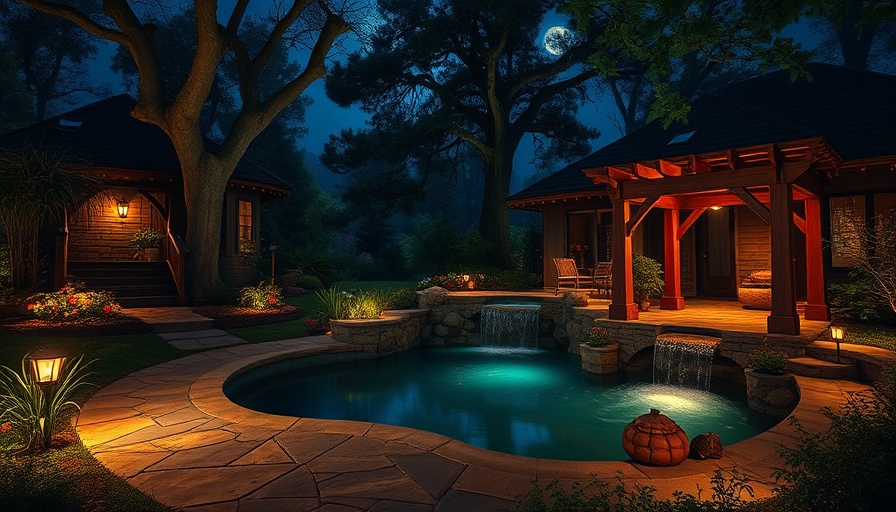
Embracing Nature: The Landscaping Trends of 2025
As we step into 2025, the world of landscaping is witnessing significant transformations, shaped by our evolving priorities and a growing commitment to sustainability. Homeowners are no longer viewing their gardens merely as decorative plots; instead, they’re striving to create functional, beautiful spaces that nurture the environment while enhancing their everyday lives. This year, we explore the top landscaping trends that emphasize eco-friendliness, technology integration, and innovative design.
Modern Water Features: A Fusion of Design and Serenity
The incorporation of water features in landscaping is reaching new heights in 2025 with a move towards sleek, modern aesthetics. Minimalist designs, such as pondless waterfalls and reflective pools, provide tranquility while creating a visual focal point within outdoor spaces. These elements not only enhance the landscape but also promote a sense of calm.
How to Implement: Opt for water features made with natural materials like stone or metal, focusing on clean lines that enhance your contemporary design. Consider how these features interact with other elements of your landscape to create a cohesive flow, contributing to the overall atmosphere.
Prioritizing Sustainability: Eco-Friendly Landscaping
In 2025, the push for sustainable landscaping practices is at an all-time high. Homeowners are increasingly choosing native plants that demand less water and maintenance, thereby reducing their environmental impact. Techniques such as rain gardens and bioswales are popular for effectively managing stormwater, all while elevating the beauty of outdoor spaces.
How to Implement: Research which plants are native to your region and integrate them into your garden design. Additionally, consider using permeable paving materials for patios and driveways, which help with groundwater replenishment and reduce runoff.
Smart Technology in the Garden: Efficiency at Your Fingertips
Technology is revolutionizing landscaping in 2025, making significant strides into outdoor living spaces. Smart irrigation systems, lighting controls, and even robotic lawn mowers allow for enhanced convenience and efficiency. With smartphone applications and smart home devices, maintaining your garden can now be simplified to just a few taps or voice commands.
How to Implement: Upgrade your irrigation system to monitor weather conditions and adjust watering schedules automatically. Consider integrating smart garden lights that can be controlled remotely, enhancing both security and aesthetics.
Outdoor Living: Expanding the Home Experience
The conception of outdoor spaces as true extensions of the home is gaining momentum in 2025. Homeowners are investing in fully equipped outdoor kitchens, cozy lounge areas with fireplaces, and comfortable furnishings that promote year-round use. These evolving outdoor living spaces emphasize both comfort and functionality, creating welcoming environments for gatherings.
How to Implement: Choose durable outdoor furniture that can withstand the elements, and consider adding structures like pergolas or retractable awnings for flexible usage throughout the year. Invest in features like fire pits to create a cozy atmosphere on cooler evenings.
Low-Maintenance Landscaping: A Stress-Free Garden
As life becomes increasingly busy, the desire for low-maintenance landscaping is more pronounced. Homeowners are seeking features that minimize upkeep while still providing visual interest. This includes strategic hardscaping solutions combined with drought-resistant plants and the use of artificial turf.
How to Implement: Incorporate ground covers to replace traditional lawns, select evergreens requiring minimal pruning, and use decorative gravel or mulch to suppress weeds. This strategy not only reduces maintenance time but also enhances aesthetic appeal.
Pollinator Gardens: Enhancing Biodiversity
One of the most significant trends for 2025 is the emergence of pollinator-friendly gardens. These vibrant spaces attract essential pollinators like bees, butterflies, and hummingbirds, supporting local ecosystems while bringing colors and life into the landscape.
How to Implement: Plant wildflowers, lavender, and milkweed, while steering clear of pesticides that can harm these vital insects. Creating habitats that cater to pollinators not only boosts biodiversity but also contributes to the health of your local environment.
Making Informed Choices with Landscaping Trends
Understanding and embracing the landscaping trends of 2025 empowers homeowners to create outdoor spaces that reflect both personal style and environmental responsibility. By integrating modern designs, sustainable practices, and technological advancements, it’s possible to cultivate beautiful, functional landscapes that serve as an oasis right outside your door.
As the importance of sustainable and functional outdoor spaces continues to grow, these trends will undoubtedly shape the future of landscaping, encouraging creativity and thoughtful design.
In light of these evolving trends, explore your options and start planning your dream landscape today. Whether you seek tranquility, sustainability, or innovative design, 2025 presents unlimited opportunities to transform your garden.
 Add Row
Add Row  Add
Add 




 Add Row
Add Row  Add
Add 

Write A Comment